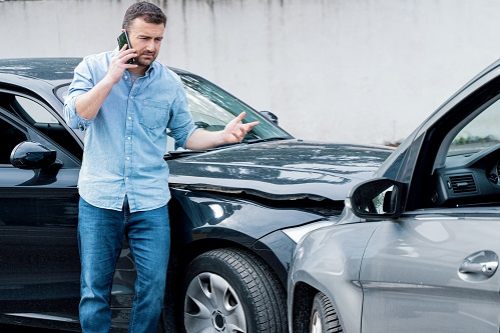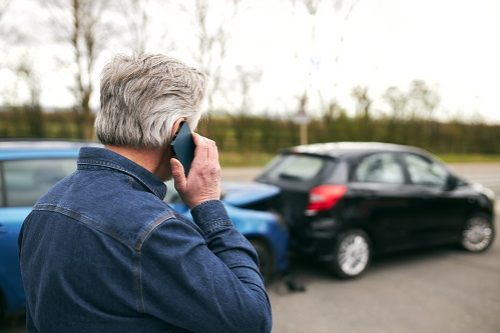- What liability car insurance is (and how it works to protect you)
- What liability car insurance covers (to protect you)
- What liability insurance doesn't cover
- How much liability insurance costs (and why it's worth it)
- State minimum car insurance limits (the lowest amount you can buy)
- How much liability coverage should you buy?
- Penalties for driving without liability insurance
- How to choose the right liability coverage
- Wrapping up: What we want you to understand about liability insurance
- Methodology
- FAQ: Real questions about liability insurance
What liability car insurance is (and how it works to protect you)
Liability insuranceLiability insurance covers sums that an insured becomes legally obligated to pay because of bodily injuries or property damage, or financial losses caused to other people. pays for injuries and damages to others if you are at fault in an accident and legally liable for damages.
It's divided into two types: bodily injury and property damage liability, which are separated into three different limits.
- Bodily injury is paid per person and per incident, with two limits. The first limit is how much the insurance company will pay for any one person injured in an accident. The second limit is how much it will pay for everyone injured in a single accident.
- Property damage has only one limit, covering all vehicles and other property damage in an accident.
Limits are written as a set of numbers, for example, 100/300/100.
Understanding liability coverage numbers: What 100/300/100 means
The three numbers in the example: 100/300/100, are your coverage limits:
- $100,000 for bodily injury per person
- $300,000 for bodily injury per incident
- $100,000 for property damage per incident
Each number is the maximum your car insurance company will pay if you cause an accident.
EXPERT TIP: Buy more than the legally required minimum. Why? The average cost of a new car just broke $50,000. Only North Carolina requires that much property damage coverage as the legal minimum.
What liability car insurance covers (to protect you)
Auto liability insurance covers damage to vehicles and injuries of others that result from an accident you caused.
| Coverage | What it pays for | How it covers you | Real-life example |
|---|---|---|---|
| Bodily injury (BI) per person | Medical bills, lost wages, and pain suffering for any one person injured | Pays the bills for one person, up to the limit | You rear-end another car and the other driver has whiplash, requiring medical care |
| Bodily injury (BI) per incident | Medical bills, lost wages, and pain and suffering for all people injured | Pays the bills for everyone injured, up to the limit | You side-swipe a car while changing lanes, running it off the road, and three people are injured, needing medical care |
| Property damage (PD) per incident | Repair or replacement of any property you damage belonging to someone else | Pays the cost of repair or replacement, up to the limit | You lose control of your car, hit another car, and then crash into a fence |
You should know: Liability insurance also obligates your insurer to defend you if you're sued following a motor vehicle accident.
What liability insurance doesn't cover
Liability insurance doesn't cover anything other than injuries and damage to other people. It doesn't cover:
- Damage to your vehicle; you need collision and comprehensive coverage to pay for those damages.
- Your medical expenses. If you have personal injury protection (PIP) or MedPay, these coverages will pay your medical bills in conjunction with your health insurance.
- Claims that exceed the limits of your coverage. Higher liability limits can help you avoid paying out-of-pocket when damages exceed minimum limits, and an umbrella policy can offer limits of $1 million or more once your auto insurance limits are reached.
How much liability insurance costs (and why it's worth it)
State minimum auto liability insurance coverage averages $618 a year, or $52 a month nationwide. Bumping that up to liability limits of 50/100/50 costs $801 annually or $67 a month.
You'll get the cheapest insurance rate if you buy a minimum liability policy. However, increasing your limits above state minimums provides more protection for a small additional cost.
Case study: When minimums fall short
Alaina, a 32-year-old driver in Illinois, carries the state minimum coverage of 25/50/20. She runs a red light and hits a vehicle carrying a family of four. Three people are taken to the hospital with serious injuries.
- The cost: The total medical bills hit $80,000 and the car is a total loss at a value of $34,000
- The coverage: State minimum liability covers $50,000 of the medical bills and $20,000 of the total loss to the vehicle.
- The out-of-pocket: Alaina owes $30,000 in medical bills and $14,000 in property damage
The average difference in cost between state minimum coverage and 50/100/50 coverage in Illinois is $40 a year. That $40 could have saved Alaina $44,000 she doesn't have.
Look at the numbers below to see the average difference between a state minimum policy and 50/100/50 liability limits; note that there are bigger differences in states with much lower minimum coverage.
| State | State minimum | Liability only 50/100/50 | $ difference | % increase |
|---|---|---|---|---|
| Alaska | $415 | $542 | $127 | 31% |
| Alabama | $514 | $703 | $189 | 37% |
| Arkansas | $503 | $763 | $260 | 52% |
| Arizona | $662 | $964 | $302 | 46% |
| California | $751 | $1,016 | $265 | 35% |
| Colorado | $547 | $898 | $351 | 64% |
| Connecticut | $1,039 | $1,119 | $80 | 8% |
| Washington, D.C. | $896 | $1,125 | $229 | 26% |
| Delaware | $1,277 | $1,498 | $221 | 17% |
| Florida | $1,208 | $2,220 | $1,012 | 84% |
| Georgia | $780 | $1,058 | $278 | 36% |
| Hawaii | $425 | $603 | $178 | 42% |
| Iowa | $330 | $405 | $75 | 23% |
| Idaho | $423 | $491 | $68 | 16% |
| Illinois | $462 | $503 | $41 | 9% |
| Indiana | $445 | $535 | $90 | 20% |
| Kansas | $520 | $579 | $59 | 11% |
| Kentucky | $708 | $957 | $249 | 35% |
| Louisiana | $993 | $1,664 | $671 | 68% |
| Massachusetts | $621 | $809 | $188 | 30% |
| Maryland | $815 | $840 | $25 | 3% |
| Maine | $377 | $384 | $7 | 2% |
| Michigan | $714 | $761 | $47 | 7% |
| Minnesota | $585 | $628 | $43 | 7% |
| Missouri | $544 | $645 | $101 | 19% |
| Mississippi | $510 | $729 | $219 | 43% |
| Montana | $422 | $604 | $182 | 43% |
| North Carolina | $644 | $717 | $73 | 11% |
| North Dakota | $354 | $377 | $23 | 6% |
| Nebraska | $369 | $422 | $53 | 14% |
| New Hampshire | $447 | $486 | $39 | 9% |
| New Jersey | $1,124 | $1,199 | $75 | 7% |
| New Mexico | $475 | $728 | $253 | 53% |
| Nevada | $908 | $1,540 | $632 | 70% |
| New York | $1,070 | $1,191 | $121 | 11% |
| Ohio | $390 | $474 | $84 | 22% |
| Oklahoma | $452 | $734 | $282 | 62% |
| Oregon | $715 | $775 | $60 | 8% |
| Pennsylvania | $421 | $586 | $165 | 39% |
| Rhode Island | $761 | $954 | $193 | 25% |
| South Carolina | $682 | $918 | $236 | 35% |
| South Dakota | $382 | $418 | $36 | 9% |
| Tennessee | $515 | $623 | $108 | 21% |
| Texas | $620 | $900 | $280 | 45% |
| Utah | $708 | $870 | $162 | 23% |
| Virginia | $528 | $538 | $10 | 2% |
| Vermont | $299 | $323 | $24 | 8% |
| Washington | $490 | $864 | $374 | 76% |
| Wisconsin | $407 | $479 | $72 | 18% |
| West Virginia | $577 | $651 | $74 | 13% |
| Wyoming | $286 | $327 | $41 | 14% |
State minimum car insurance limits (the lowest amount you can buy)
States set their own minimum liability coverage requirements for property damage and bodily injuries. These limits vary by state. For example, California's requirements are 15/30/5, some of the lowest limits of any state. On the other hand, Alaska has some of the highest required limits at 50/100/25.
The list below shows the liability insurance minimums for every state. Additionally:
- Twelve no-fault states require all drivers to carry personal injury protection (PIP) to pay for their medical expenses if involved in an accident.
- A few states, such as Maine and New Hampshire, require medical payments (MedPay), which provides some medical coverage if you or your passengers are injured in an auto accident.
- Many states require you to carry uninsured motorist bodily injury (UM)/underinsured motorist (UIM) coverage. Some states require uninsured motorist property damage (UMPD).
- Although New Hampshire doesn't require drivers to carry auto insurance, it does have financial responsibility laws.
| State | Minimum liability coverages | Other types of insurance required (if any) |
|---|---|---|
| Alaska | 50/100/25 | |
| Alabama | 25/50/25 | |
| Arkansas | 25/50/25 | |
| Arizona | 25/50/15 | |
| California | 30/60/15 | |
| Colorado | 25/50/15 | |
| Connecticut | 25/50/25 | UIMBI and UMBI |
| Washington, D.C. | 25/50/10 | UMBI and UMPD |
| Delaware | 25/50/10 | |
| Florida* | 10/20/10' | PIP |
| Georgia | 25/50/25 | |
| Hawaii | 20/40/10 | PIP |
| Iowa | 20/40/15 | |
| Idaho | 25/50/15 | |
| Illinois | 25/50/20 | UMBI |
| Indiana | 25/50/25 | |
| Kansas | 25/50/25 | PIP and UMBI |
| Kentucky | 25/50/25 | PIP |
| Louisiana | 15/30/25 | |
| Massachusetts | 20/40/5 | Mandatory BI, PIP, UIMBI and UMBI |
| Maryland | 30/60/15 | PIP****, UMBI and UMPD |
| Maine | 50/100/25 | Med and UMBI |
| Michigan | 50/100/10 | PIP and Property Protection |
| Minnesota | 30/60/10 | PIP, UIMBI and UMBI |
| Missouri | 25/50/25 | UMBI |
| Mississippi | 25/50/25 | |
| Montana | 25/50/20 | |
| North Carolina****** | 30/60/25 | UMBI and UMPD |
| North Dakota | 25/50/25 | PIP, UIMBI and UMBI |
| Nebraska | 25/50/25 | UIMBI and UMBI |
| New Hampshire** | 25/50/25 | Med, UIMBI and UMBI |
| New Jersey***** | 25/50/25 | PIP, UIMPD, UMBI and UMPD |
| New Mexico | 25/50/10 | |
| Nevada | 25/50/20 | |
| New York | 25/50/10 | PIP, UIMBI and UMBI |
| Ohio | 25/50/25 | |
| Oklahoma | 25/50/25 | |
| Oregon | 25/50/20 | PIP and UMBI |
| Pennsylvania | 15/30/5 | PIP |
| Rhode Island*** | 25/50/25 | |
| South Carolina | 25/50/25 | UMBI and UMPD |
| South Dakota | 25/50/25 | UIMBI and UMBI |
| Tennessee | 25/50/25 | |
| Texas | 30/60/25 | |
| Utah | 30/65/25 | PIP |
| Virginia | 50/100/25 | UMBI and UMPD |
| Vermont | 25/50/10 | UIMBI, UMBI and UMPD |
| Washington | 25/50/10 | |
| Wisconsin | 25/50/10 | UMBI |
| West Virginia | 25/50/25 | UIMBI, UIMPD, UMBI and UMPD |
| Wyoming | 25/50/20 |
* Florida doesn't require bodily injury liability coverageThis auto insurance coverage helps pay for medical expenses and lost wages if you injure someone in a car accident. It also covers legal fees if you're sued., but many insurers only offer policies with at least minimum amounts of 10/20 of BI coverage.
** In New Hampshire, auto insurance isn't mandatory, but if you choose to buy insurance these are the minimum amounts.
*** Rhode Island doesn't require drivers to buy UM/UIM coverage if buying minimum liability coverage. If you buy higher liability limits, UM is required.
****Full PIP can be waived in Maryland for a limited PIP option.
*****New Jersey offers a basic car insurance policy with lower liability limits than the legal requirement.
How much liability coverage should you buy?
The simple answer: you should buy more than the state minimum. How much more? As much as you can afford. Of course, budgets are tight, but consider the risk of losing everything versus the cost of a little more insurance. Especially if:
- You have teen drivers (they're four times more likely to be in a crash)
- You drive a lot (the more you're on the road, the higher the risk)
- There are multiple drivers and vehicles in your household (more drivers, more risk)
- You have a lot of assets (you're a lawsuit target)
Personal note: When I added my teenager to my insurance, I was tempted to decrease the liability limits to offset the huge increase in rates. Knowing the high risk of a teen driver causing an accident held me back. Higher liability limits protect me and everything I have worked for, especially with the increased risk.
Use our auto insurance coverage calculator to find out what coverage limits best fit your needs, and don't forget: you can raise your coverage right now; you don't have to wait for renewal.
Penalties for driving without liability insurance
If you are caught driving without insurance, you may face:
- Driver's license suspension
- Registration suspension
- Fines ranging from $600 to $5,000
- DMV lapse fees
- Vehicle impoundment
- Jail time or community service
- Points on your license
- A requirement to carry SR-22 insurance
Get the details on penalties for driving without insurance in your state.
By driving without insurance, you're gambling with your future. In addition, you will be responsible for any financial damages if you cause an accident while uninsured.
How to choose the right liability coverage
You should review your policy once a year and ensure your assets and income are fully protected.
- Shop around at least once a year. Rates change over time; you might not have the best deal anymore.
- Compare at least three quotes. Make sure the quotes you receive all include the same coverage so that you can make a valid comparison.
- Ask about discounts. Reduce your rates so you can spend the money on better coverage.
- Update your policy when anything changes. When you have a life-changing event during the year – such as adding a teen driver, marriage, divorce, moving, adding or removing a vehicle – it’s particularly important to comparison shop.'
Wrapping up: What we want you to understand about liability insurance
Liability insurance isn't an option (except in New Hampshire), but it's important to see it not as an obligation but what it really is: protection for you and everything you've worked for.
Everyone, even good drivers, makes mistakes. A moment with your eyes off the road is all it takes. Liability insurance protects others from your very human mistakes, but it also protects you. Having the right coverage means peace of mind every time you get behind the wheel.
Methodology
We partnered with Quadrant Information Services to field average car insurance rates in all 50 states and Washington, D.C.
National and state average rates are based on two liability-only coverage levels: state minimum and 50/100/50 liability-only, and based on a sample driver:
- 40-year-old driver
- Honda Accord LX
- Good credit
- A clean driving record
- 12-mile commute, 10,000 annual mileage
Learn more about our data and methodology.
Sources:
- Kelley Blue Book. "New Record: Average New Car Price Surpasses $50,000." Accessed October 2025.
- IIHS. "Teenagers." Accessed October 2025.
FAQ: Real questions about liability insurance
Is liability insurance enough?
Not if you have a loan on your car or can't afford to repair or replace it. Liability insurance doesn't cover your car. You need comprehensive and collision for that.
Does liability cover rental cars?
Your personal car insurance generally extends to rental cars, but it's always a good idea to confirm with your insurer.
Can I raise my coverage in the middle of the policy?
Yes, you can change your coverage at any time.
What's a good liability limit for a family?
Experts recommend a minimum of 100/300/1000; more if you have a lot of assets.






